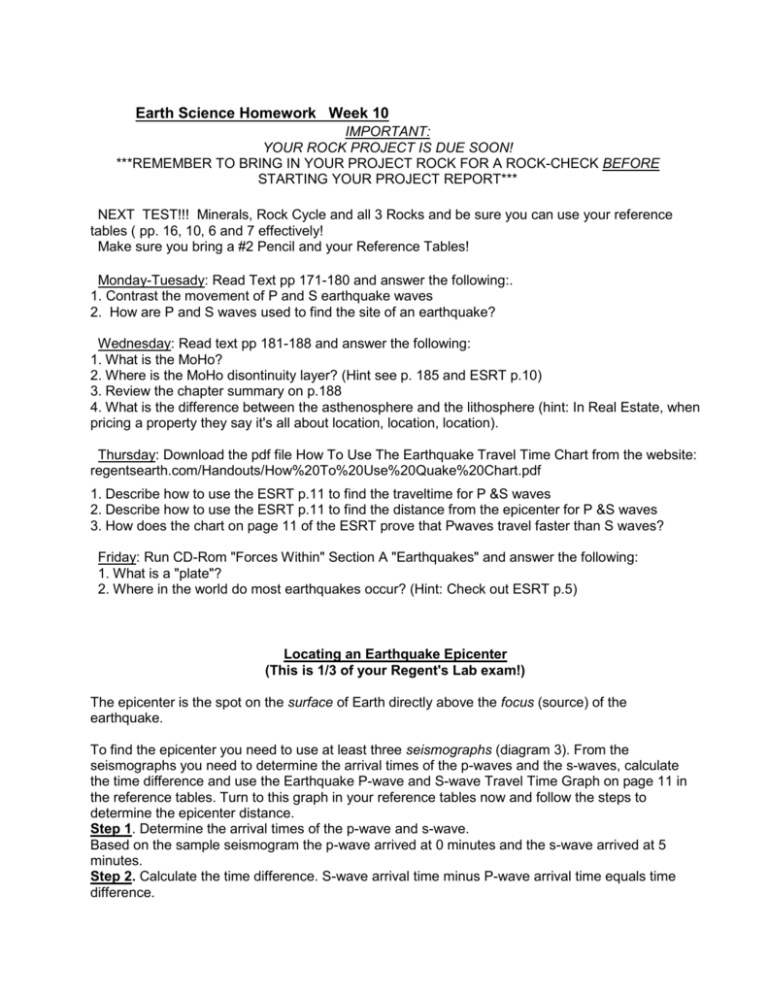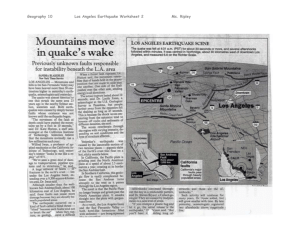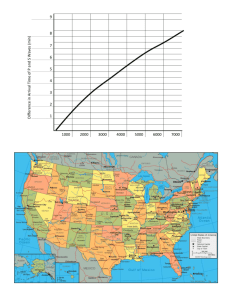Earth Science Homework Week 10
advertisement

Earth Science Homework Week 10 IMPORTANT: YOUR ROCK PROJECT IS DUE SOON! ***REMEMBER TO BRING IN YOUR PROJECT ROCK FOR A ROCK-CHECK BEFORE STARTING YOUR PROJECT REPORT*** NEXT TEST!!! Minerals, Rock Cycle and all 3 Rocks and be sure you can use your reference tables ( pp. 16, 10, 6 and 7 effectively! Make sure you bring a #2 Pencil and your Reference Tables! Monday-Tuesady: Read Text pp 171-180 and answer the following:. 1. Contrast the movement of P and S earthquake waves 2. How are P and S waves used to find the site of an earthquake? Wednesday: Read text pp 181-188 and answer the following: 1. What is the MoHo? 2. Where is the MoHo disontinuity layer? (Hint see p. 185 and ESRT p.10) 3. Review the chapter summary on p.188 4. What is the difference between the asthenosphere and the lithosphere (hint: In Real Estate, when pricing a property they say it's all about location, location, location). Thursday: Download the pdf file How To Use The Earthquake Travel Time Chart from the website: regentsearth.com/Handouts/How%20To%20Use%20Quake%20Chart.pdf 1. Describe how to use the ESRT p.11 to find the traveltime for P &S waves 2. Describe how to use the ESRT p.11 to find the distance from the epicenter for P &S waves 3. How does the chart on page 11 of the ESRT prove that Pwaves travel faster than S waves? Friday: Run CD-Rom "Forces Within" Section A "Earthquakes" and answer the following: 1. What is a "plate"? 2. Where in the world do most earthquakes occur? (Hint: Check out ESRT p.5) Locating an Earthquake Epicenter (This is 1/3 of your Regent's Lab exam!) The epicenter is the spot on the surface of Earth directly above the focus (source) of the earthquake. To find the epicenter you need to use at least three seismographs (diagram 3). From the seismographs you need to determine the arrival times of the p-waves and the s-waves, calculate the time difference and use the Earthquake P-wave and S-wave Travel Time Graph on page 11 in the reference tables. Turn to this graph in your reference tables now and follow the steps to determine the epicenter distance. Step 1. Determine the arrival times of the p-wave and s-wave. Based on the sample seismogram the p-wave arrived at 0 minutes and the s-wave arrived at 5 minutes. Step 2. Calculate the time difference. S-wave arrival time minus P-wave arrival time equals time difference. Step 3. Now turn to the Earthquake Time Travel Graph on page 11 in your reference tables. Place a sheet of paper along the Travel Time axis of the graph as shown below and mark the time difference calculated in step 2. Step 4. Now slide the piece of paper straight across the graph until the bottom mark lines up with the p-wave line and the top mark lines up with the s-wave line. Make sure the edge of the paper is parallel to the vertical lines on the graph. Step 5. Now read straight down the edge of the paper until it crosses the Epicenter Distance axis. This is the answer. Based on the sample seismogram the epicenter distance is 3,600 km. Step 6. Check the scale on your map. It should look something like a piece of a ruler. All maps are different. On your map, one centimeter could be equal to 100 kilometers or something like that. Figure out how long the distance to the epicenter (in centimeters) is on your map. For example, if your map has a scale where one centimeter is equal to 100 kilometers. The epicenter of the earthquake is 3,600 kilometers away, which equals 3.6 centimeters on the map. Step 7, Using your compass, draw a circle with a radius equal to the number you came up with in Step #6 (the radius is the distance from the center of a circle to its edge). The center of the circle will be the location of your seismograph (Louisville in this case). Step 8. The real epicenter of the earthquake is somewhere on the edge of the circle. To find out exactly where it is, you need 2 more reporting stations (1 if you’re really lucky and the 2 circles just touch) and then repeat steps 1-7 two more times. You will end up with 3 circles that only meet in one location: this is the epicenter. The process is called “triangulation”. ESRT p.11: Regents Earth Science Homework Week 11 ***Refer to this sheet in addition to your text*** WHAT CAUSES EARTHQUAKES? An earthquake is any shaking, or rapid motion of Earth's solid outer layers. Most earthquakes occur when stress builds along a zone of weakness or a crack where previous motion has occurred. These areas are callled faults. When stress on the crust is greater than it can resist the crust shifts and breaks suddenly releasing energy. This energy radiates in all directions as waves. EARTHQUAKE WAVES Ground motion radiates from the focus of an earthquake in energy waves in the form of vibrations. The place underground where the break first occurs is the focus of the earthquake. The epicenter is the location at Earth's surface just above the focus. When the vibrations reach the surface, we feel them as an earthquake, first at the epicenter and then at greater distances from the epicenter. P-waves travel the fastest. In addition to standing for Primary, "P" also stands for push-pull, which describes the ground's motion as these waves pass. The vibration of a P-wave is like the motion of a spring when it is alternately pulled tighter and then released. The second category is S-waves, "S" standing for Secondary or side-to-side. (S-waves vibrate in all directions perpendicular to the direction of travel.) S-wave motion is like the wave that travels down a rope or spring when one end is moved quickly from side-to-side. S-waves travel more slowly than P-waves. MEASURING EARTHQUAKES Earthquakes are measured using intensity and magnitude scales. Intensity scales, such as the Mercalli scale, are based on the effects on people who experienced the earthquake or observed the amount of destruction it caused. Intensity scales do not measure the energy level of an earthquake, The intensity at which an earthquake is felt depends on the observer's distance from the epicenter and the ability of the ground to transmit this energy. Shaking caused by an earthquake is stronger in locations built on sediments and landfill. Structures built on solid bedrock are more likely to survive an earthquake. It is not uncommon for the greatest damage to occur many kilometers from an earthquake's epicenter. Seismometers (Instruments that detect vibrations of the ground These instruments operate on the principle that a heavy weight suspended on a spring tends to remain steady while the ground shakes. A pen is attached to the weight. During an earthquake, the pen remains stationary while the ground and the surface it writes on shake. The pen makes tracings on the paper (a seismograph) attached to the revolving drum. Magnitude scales, such as the one developed by Charles Richter to show the energy of an earthquake are logarithmic (each increase of one unit means a 10-fold increase in shaking). Therefore, a magnitude 7 earthquake has 10 times as much shaking as a magnitude 6 event and 100 times more shaking than a magnitude 5. LOCATING THE EPICENTER A seismograph records the magnitude of an earthquake and the time the seismic waves arrive. Seismologists use the difference in the speeds of P- and S-waves to locate the epicenters of earthquakes. The graph "Earthquake P-wave and S-wave Travel Time" found on the Earth Science Reference Tables page 11 shows how long it takes P- and S-waves to travel different distances through Earth. As the seismic waves travel outward from the focus, the time delay between the Pwaves and S-waves increases. Finding Your Distance From an Earth¬quake Epicenter To determine your distance from an earthquake epicenter, proceed as follows: 1. Subtract the arrival time of the P-waves from the arrival time of the S-waves. (This can be expressed in hours, minutes, and seconds, such as 08:06:40, or just hours and minutes such as 15:25 (3:25 p.m.) (6 minutes 40 seconds in this example) 2. On the clean edge of a sheet of paper, make two marks to show the observed interval along the travel-time scale on the vertical axis of the "Earthquake P-wave and S-wave Time Travel" graph (p.11). 3. Keeping the edge of the paper vertical, slide the marks on the edge of your paper along the Pand S-curves of the travel-time scale until the marks match up with both curves. 4. Carefully follow the marked edge of your paper straight down to the horizontal axis to find the distance to the epicenter. (5,000 km in this example) This procedure has not yet located the epicenter, but it has established the distance from one recording station to the epicenter. If you draw a circle around the recording station with a radius equal to that distance, the epicenter should be located somewhere along that circle. To find the exact location, follow the procedure above and find the distances from the epicenter to at least three seismic recording stations (triangulation). Use a compass to draw a circle around each station at the proper distance for that station. The epicenter is the point where the circles intersect (meet). In reality the circles seldom intersect at a single point. More often, they make a small triangle. The location of the epicenter is probably near the center of that triangle. THE ORIGIN TIME OF AN EARTHQUAKE The farther an observer is from an earthquake's epicenter, the longer it takes the waves to reach that observer. Therefore, an observer may know immediately when he or she feels the vibrations, but may not know when the earthquake really occurred at the epicenter. To find the origin time (the time at which the earthquake occurred at its epicenter), a seismologist needs to know the time at which the earthquake was first recorded at any recording station. That is, the arrival time of the P-waves. The seismologist also needs to know the amount of time that the Pwaves took to get there (the travel time). If the distance to the epicenter (as found in the section above) is known, the travel time can be read from the "Earthquake P-wave and S-wave Travel Time" graph on p.11 of the ESRT by finding the distance at the bottom of the chart and then reading up from that point to where it meets the wave line. The time is then read directly to the left from that point on the wave line. For example, if the epicenter of an earthquake is 4000 kilometers away, the travel time for P-waves must be 7 minutes. Suppose an earthquake was recorded at a station at 2:25 p.m. (14:25:00 in 24hour time) and the P-waves took 7 minutes to get there. (That is the travel time.) Therefore, the earthquake must have actually happened 7 minutes earlier at the epicenter. So the origin time was 2:18 P.M. (14:18:00). HOMEWORK: Answer the following 7 questions1. As the distance from an earthquake epicenter increases, the time between P-wave arrival and Swave arrival will (1) decrease (2) increase (3) remain the same. 2. If an S-wave arrives 4 minutes after an earthquake occurs at the epicenter, how far away is the epicenter? (1) 1000 km (2) 2000 km (3) 7000 km (4) 10,000 km 3. Station Z. is 1700 km from the epicenter. How long did it take the P-waves to travel to station Z? (1) 1 min, 50 s (2) 2 min, 50 s (3) 3 min, 30 s (4) 6 min, 30 s. 4. An earthquake occurred at 02:00:00. When would the first P-waves arrive at a seismic recording station 8000 kilometers away? (1) 01:51:50 (2) 02:08:20 (3) 02:11:20 (4) 10:51:50 5. Which station is the farthest from the epicenter? (1) A (2) B (3) C (4) D 6. If the P-wave arrived at station A at 09:25:30, what was the origin time of the earthquake at the epicenter? (1) 06:05:53 (2) 09:17:10 (3) 09:23:30 (4) 12:45:30 7. How far from the epicenter was Station D? (1) 800 km (2) 1600 km (3) 2000 km (4) 5 100 km Answers to week 11 homework: 1-2, 2-1, 3-3, 4-3, 5-3, 6-2, 7-2 Regents Earth Science Homework Week 12 <Cop this sheet and bring it to class each day this week and keep it for your review!> Use the following 6 steps to find the epicenter for an earthquake:: Step 1: Subtract the arrival time of the p-waves from that of the s-waves. Step 2: Mark the two intervals showing that interval on the “travel-time” scale using the straight edge of a paper. Step 3: Slide the paper with the marks on it until the marks line up with the p- wave and s- wave lines. This will tell you the distance of the epicenter from the recording station. Use the distance as a radius for a circle, and draw a circle around the recording station. Step 4: Repeat steps 1 through 3 for a second recording station. Step 5: Repeat steps 1 through 3 for a third recording station. Step 6: The location where the 3 circle intersect is the epicenter. Monday: Subtract the following times. Write your answers with hours, minutes, and seconds (hh:mm:ss) beneath the times in each box below. Remember: There are 24 hours in one day, 12 hours on most clocks, 60 minutes in an hour, and 60 seconds in a minute. 10:09:50 -10:08:25 9:45:10 -9:25:10 3:15:33 -3:14:43 7:22:55 -7:21:55 4:15:57 -4:14:30 1:24:43 -1:22:05 04:28:53 -03:52:41 07:49:36 -04:03:51 Tuesday: Locate the epicenter of the 1989 San Francisco Earthquake: 1. The epicenter of this earthquake is located at _________________________________ Wednesday: Answer the following questions: 1. What is the epicenter of an earthquake? 2. What is the focus of an earthquake? 3. How long does it take an S-wave to travel 7,000 km? 4. A P-wave arrives 10 minutes before the S-wave. How far away was the epicenter? 5. How far does an S-wave travel in 15 minutes? 6. How far does a P-wave travel in 4 minutes? 7. In 12 minutes and 40 seconds how far will an S-wave travel? 8. How long will it take an S-wave to travel 2,600 km? 9. How long does it take a P-wave traveling 5,600 km to reach a seismic station's seismograph? 10. The P and S wave times are 5 minutes 40 seconds apart. How far was the epicenter? 09:15:24 -02:16:25 Thursday: Locate the Great Alaska earthquake epicenter. When an earthquake occurs it sends a disturbance through Earth. These waves are recorded by seismometers. A seismometer is a device for measuring ground movement. Scientists can use information recorded by seismometers to find the epicenter of an earthquake. The epicenter is the place on Earth’s surface directly above where the earthquake started. To locate an epicenter, scientists need three seismometers to record the earthquake, and they must determine the distance between the epicenter and each seismometer. An earthquake can cause an uplift of a section of Earth’s crust. If this uplift occurs on the sea floor, it displaces the water above it, generating a tsunami. Earthquakes also can cause landslides that change the shape of the sea floor and generate tsunamis. The 1964 Great Alaska Earthquake generated tsunami waves that devastated several coastal Alaska towns and villages. Use the scale on the map to set the radius of your compass. Match the distance from the Sitka seismometer station to the epicenter. This distance is provided in the data chart below. After you set the radius of your compass, put the compass pointer on the dot that shows the location of the Sitka seismometer. 1. Draw a circle around the Sitka seismometer. The epicenter of the earthquake will be somewhere along this circle. 2. Repeat steps 1 and 2 for the other two seismometer stations. When you finish, three circles should be drawn on your map, one around each seismometer station. The point at which these three circles meet is the epicenter of the earthquake. On the map below, mark an “X” where you think the epicenter of the Great Alaska Earthquake of 1964 was located. Friday: Use the example above to answer the folowing: 1. Could you have determined the location of the 1964 earthquake epicenter with information from two seismometer stations instead of three? Explain your answer. 2. Do all earthquakes generate tsunamis? How do you know? 3. If you were to use data from three otherseismic stations that recorded the 1964 earthquake, would you identify the same epicenter? Explain your answer using complete sentences.







